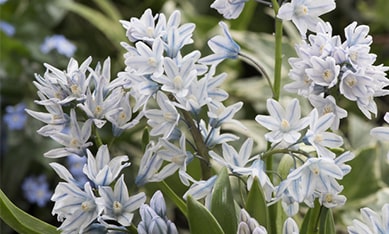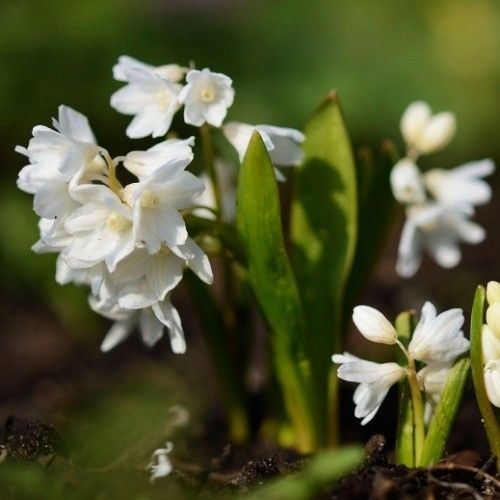
Puschkinia
Puschkinia
Last Reviews
Discover the Captivating Beauty of Puschkinia: A Must-Have for Your Garden
Are you in search of an exceptional and captivating addition to your garden, one that will bring vibrant hues and an organic allure to your surroundings? Search no more! Introducing Puschkinia, a botanical gem that no gardening aficionado should be without. Within this piece, we shall delve into the diverse traits of Puschkinia, delve into its cultivation and nurturing, shed light on the advantages of its presence in your garden, and offer creative suggestions for seamlessly integrating it into your home interior or outdoor oasis.
About Puschkinia
Puschkinia, an enduring plant species characterized by its bulbous nature, is indigenous to the captivating regions of the Middle East and Central Asia. Its nomenclature pays homage to the esteemed Russian botanist Apollo Mussin-Pushkin. This botanical marvel is renowned for its ethereal blossoms, boasting delicate star-like shapes that grace the early days of spring. The flowers themselves exhibit a pristine white or pale blue hue, embellished with a striking deep blue streak adorning each petal, offering an exquisite touch to any garden setting.
Characteristics of Puschkinia
Reaching heights of up to 15cm and expanding to a width of approximately 10cm, Puschkinia boasts a compact stature. This resilient plant necessitates minimal care once it has taken root. Flourishing splendidly in areas with abundant sunlight or partial shade, it exhibits notable resistance to pests and diseases. With its hassle-free cultivation and enduring charm, Puschkinia effortlessly enhances any garden, bestowing a captivating and organic allure upon your cherished space while demanding little in terms of upkeep.
Growing Puschkinia
Cultivating Puschkinia proves to be a straightforward endeavor, as it adapts effortlessly to various growing conditions. Whether you opt to nurture it indoors or outdoors, this versatile plant thrives in both settings with equal aplomb. Here are some steps to follow:
Choosing the Right Location
For optimal growth, Puschkinia thrives in well-drained soil that boasts a generous amount of organic matter. When selecting a suitable spot for planting, aim for a location that offers either full sun or partial shade. Prior to planting the Puschkinia bulbs, it is essential to prepare the soil adequately. Ensure that the soil possesses good drainage properties and an ample supply of organic matter. If the soil tends to be heavy and retains excess moisture, enhancing its drainage can be achieved by incorporating sand into the soil mixture.
Planting Puschkinia Bulbs
To ensure a successful growth cycle, it is advisable to plant Puschkinia bulbs in the autumn, before the arrival of the first frost. When planting, bury the bulbs approximately 5cm deep into the soil, leaving a spacing of approximately 10cm between each bulb. Subsequently, cover the bulbs with soil and provide them with a thorough watering. Obtaining Puschkinia bulbs is a convenient task, as they are readily accessible at garden centers and online nurseries. Moreover, their ease of planting and subsequent care make them an ideal choice for garden enthusiasts of all levels of expertise.
Caring for Puschkinia
Once planted, Puschkinia requires very little care. Water the plant occasionally during dry spells and fertilize it once a year with a balanced fertilizer. Deadhead the flowers after they have bloomed to encourage more blooms. Puschkinia is a low-maintenance plant that is ideal for busy gardeners who want a beautiful and natural-looking garden without the hassle of high maintenance.
Benefits of Puschkinia

In addition to its captivating visual allure, Puschkinia offers a range of benefits.
- This plant serves as a magnet for essential pollinators such as bees and butterflies, playing a crucial role in supporting the ecosystem.
- Furthermore, Puschkinia exhibits natural resistance to deer and rabbits, making it an ideal option for gardens located in areas with wildlife populations.
- By incorporating Puschkinia into your garden, you create an inviting haven for pollinators and wildlife, effectively enhancing the ecological diversity and vibrancy of your space.
Design Ideas with Puschkinia
Puschkinia presents a versatile element that seamlessly integrates into a myriad of design styles, enhancing both home interiors and outdoor gardens with its delicate charm. Here are some design ideas:
Border Plantings
Puschkinia is an excellent choice for border plantings. Its low-growing habit makes it ideal for edging flower beds and walkways. Plant Puschkinia bulbs along the border of your garden to create a beautiful and natural-looking border.
Rock Gardens
The delicate flowers of Puschkinia make it a splendid choice for inclusion in rock gardens. By planting it alongside other low-growing plants, you can establish a captivating and naturally blended garden. Puschkinia serves as a remarkable addition to rock gardens, introducing vibrant pops of color and infusing the space with an enchanting touch of natural beauty.
Naturalized Landscapes
To create a captivating naturalized landscape, consider planting Puschkinia bulbs in large drifts. This approach allows for a visually striking effect as the plants delicate flowers grace meadows and woodland areas with their stunning accents. By grouping Puschkinia bulbs together in substantial numbers, you can fashion a breathtaking naturalized landscape within your garden, showcasing the plants inherent beauty and creating a harmonious integration with the surrounding environment.
Common Varieties of Puschkinia
Puschkinia manifests in two prevalent varieties: Puschkinia Libanotica, characterized by its ethereal pale blue flowers, and Puschkinia Scilloides, boasting white flowers adorned with a graceful blue stripe. Both varieties of Puschkinia are known for their ease of cultivation and minimal maintenance requirements, making them accessible to gardeners of all skill levels. By incorporating either variety into your garden, you introduce a delicate charm that effortlessly enhances the overall aesthetic appeal of your outdoor space.
Where to Buy Puschkinia
Puschkinia bulbs are conveniently obtainable at numerous garden centers and online nurseries. When selecting bulbs, ensure they are firm and devoid of any signs of mold or soft spots, as these indicate potential issues. The availability of Puschkinia bulbs at most garden centers makes them easily accessible, and their affordability, along with their simple planting and care requirements, adds to their appeal as a desirable addition to any garden.
Conclusion: Enhance Your Garden with the Delicate Charm of Puschkinia
Puschkinia, with its enchanting allure and simple cultivation, serves as an exquisite plant that effortlessly imparts a delicate touch to any garden. As a low-maintenance gem, it is an essential addition for every gardening enthusiast. By incorporating Puschkinia into your garden, you not only attract vital pollinators and infuse your landscape with vibrant hues but also establish a space that exudes natural beauty and tranquility. This versatile plant seamlessly integrates into various design styles, further enhancing the visual appeal of your surroundings. Embark on the journey of adding Puschkinia to your garden today and relish in the delightful charm of this remarkable plant!
Frequently asked questions about Spring Flowering Puschkinia
How to plant Pushkinia onions?
To plant Pushkinia bulbs, follow these steps:
- Choose a site with well-drained soil and full sun to partial shade.
- Dig a planting hole about twice as deep as the bulb.
- Place the bulb in the planting hole with the point facing upwards.
- Cover the bulb with soil and press down lightly.
- Place more bulbs at the recommended distance for the particular species of Pushkinia.
- Water the bulbs thoroughly after planting.
Where can I buy Pushkinia bulbs?
Pushkinia bulbs are available in garden centres, nurseries or online shops that specialise in selling bulbs. You can visit local shops or check reputable online websites that offer a wide range of bulbs.
How do the seeds of Galanthus elwesii spread?
The seeds of Galanthus elwesii, commonly known as snowdrops, are spread by various means such as wind, water or animals. They have small structures called elaiosomes which are attractive to ants. Ants collect and disperse the seeds as they carry them to their nests, helping to spread the seeds.
How tall is Galanthus elwesii?
Galanthus elwesii is a type of snowdrop that usually reaches a height of about 15-20 cm when in flower. The flowers themselves are small and delicate, with white petals and green markings.
Where are Galanthus native to?
Galanthus or snowdrops are native to various parts of Europe, including countries such as the UK, France, Italy, Greece and Turkey. They are also found in certain regions of the Middle East and Central Asia. Snowdrops are known for their early flowering in spring, often still under the snow.













